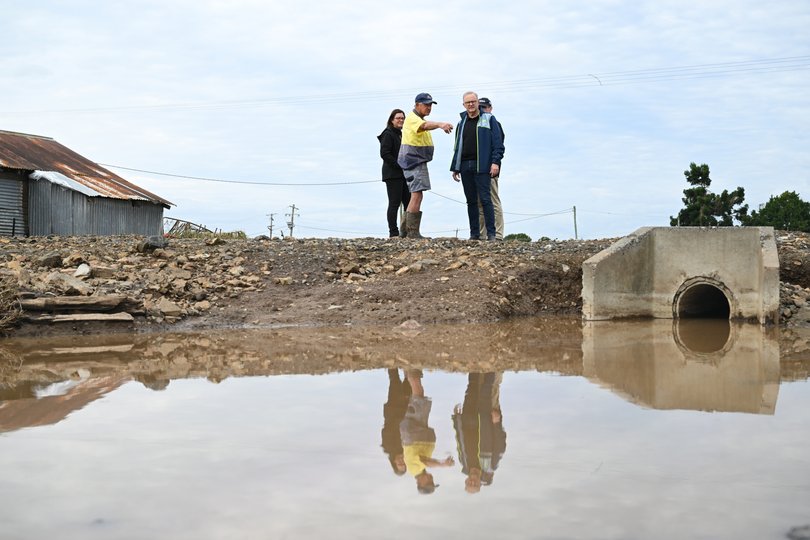NSW flood disaster: Prime Minister Anthony Albanese warns of long recovery, climate experts fear worse to come

Prime Minister Anthony Albanese on Tuesday revealed the brutal impact of severe flooding in New South Wales, warning that affected communities would need months to recover.
At a press conference in devastated Taree, on the Mid-North coast, Mr Albanese said the Government would prioritise meeting the community’s immediate needs, while promising that, “we don’t leave people behind.”
But with the frequency and intensity of climate-related natural disasters increasing, experts have warned that Australia must significantly recalibrate both its long-term preparation and prevention measures as well as its future response efforts.
Sign up to The Nightly's newsletters.
Get the first look at the digital newspaper, curated daily stories and breaking headlines delivered to your inbox.
By continuing you agree to our Terms and Privacy Policy.They say the country must invest more in mitigation and flood defence plans, adapt building infrastructure and inform the public on how to better protect itself in the decades before the global greenhouse gas emissions escalating extreme weather can be meaningfully reduced.
Mr Albanese and Emergencies Minister Kristy McBain were on the ground in Taree, which has borne the brunt of a once-in-a-500-year flooding disaster, assessing the damage and speaking with volunteers and survivors.
Their visit comes just three months after similar scenes of heartbreak and ruin when tropical cyclone Alfred battered South East Queensland and the NSW North coast.
Praising the response of the Australian Defence Force (ADF), State Emergency Service (SES) and Disaster Relief Australia (DRA), the Prime Minister said an “extraordinary number” of people had been rescued over the last week.
A total of 7,791 incidents had been reported, 795 flood rescues conducted and 15,362 calls for help, while a building survey found that 695 buildings were no longer habitable, Mr Albanese told reporters at a local press conference.
The tragic human toll of the weather catastrophe, which unfolded when heavy rainfall during a coastal trough triggered extreme flooding across Hunter and Mid-North coastal areas, was at the forefront of everyone’s minds, he said.
“The human impact we must remember first and foremost, the loss of five lives through these devastating floods, and the extraordinary hardship that people have gone through,” Mr Albanese said.
“People have spoken about the 2021 floods and how that had a devastating impact, but they thought that would be the peak. Well, this flood has been far worse, and the impact has been far more severe.”
The havoc wreaked on local communities would still be evident even after months and the economic impact on the dairy industry felt across the country, he warned.
“This will take some time, the recovery, but Australians are resilient. They’re tough, and we will come through this and we’ll come through it together,” he said.
Mr Albanese’s comments reflect mounting warnings from meteorologists and scientists that extreme weather linked to the changing climate and warming temperatures is becoming more frequent and more intense.
Emeritus Professor Mark Howden, former director of the ANU’s Institute for Climate, Energy and Disaster Solutions, said it was clear that disaster risks were increasing across the globe.
“When you look at the number of climate related insurance events, we see that increasing extraordinarily quickly,” he said. “It’s not just the frequency, but it’s also the severity of scale.”

While the overarching solution was to reduce global greenhouse gas emissions, the authorities could take more steps to minimise damage, including reapportioning spending on preparation versus response, he said.
“At the moment, most of the money on our disaster relief gets spent on the response … effectively cleaning up the mess,” he said, pointing to analyses that revealed more must be spent on preparation.
Better policies were also needed to limit the capacity for future vulnerability, like avoiding building on flood plains and taking climate change into account when constructing new infrastructure, he said.
The public could also be better informed about how to take “good risk management decisions,” added Prof. Howden.
Data from the Climate Council shows that disaster recovery funding arrangement activations for local government areas impacted by the May floods rose from 26 for the whole of 2019 to 39 in the first five months of 2025.
The Council’s Prof David Karoly, a former top official at the National Environmental Science Program, based in CSIRO, said it was clear a global reduction in emissions was required but urged the Government to reconsider its own contribution to climate change through fossil fuel exports.
“Australia is the third largest exporter of fossil fuels, but it’s not counted in Australia’s domestic emissions,” he said.
“Absolutely we should reverse that, because it will benefit Australian communities in terms of reducing the impact of climate change in Australia, and it will reduce global warming for all people on the planet,” he argued.
The Prime Minister on Tuesday announced the Government would expand financial assistance for communities in the New South Wales Hunter and Mid North Coast by activating the Australian Government Disaster Recovery Payment (AGDRP) and extending the Disaster Recovery Allowance (DRA). The AGDRP helps those who have suffered the most serious impacts, including major damage to their home, serious injury, or loss of a loved one as a result of severe weather by providing a one-off payment of $1,000 per eligible adult and $400 per eligible child. Mr Albanese also cautioned insurance companies “to do right by their customers and swiftly process claims,” adding that an office has been set up in the area to help people process the paperwork.
“We’re in early stages. What we’re about is making sure that people are looked after in the immediate sense,” he said.
“Our focus now is on the clean-up and recovery from this event. That’s our focus, the immediate needs. That’s what people here expect us to do. Yes, there are longer term issues that need to be looked at,” he said.
Insurers have also called for longer term solutions to an ongoing problem.

Ahead of the Federal election, the Insurance Council of Australia issued a policy paper for the next Government, warning that “worsening disasters fuelled by a changing climate are pushing up insurers’ costs.”
It called specifically for the “creation of a $30.15 billion, ten-year Flood Defence Fund to deliver new flood defence infrastructure, strengthen or remove properties in harm’s way, and future-proof existing flood mitigation infrastructure.”
CEO Andrew Hall said such a fund, for example, could complete a levee wall that would protect the CBD of Taree.
“These are the sorts of programs that we need funding to be in place for on a permanent arrangement, because as time goes on, we’re getting better data and we understand exactly how the floods are behaving,” he said.
The fund would be shared between State and Federal Governments and would help communities decide how best to defend their properties, Mr Hall added.
“The government has been very keen to work with the industry on peril data - getting all the data in one place to understand where the biggest challenges are,” he said.
“If they can see where the highest risk areas are, the same way insurers can, it enables them to prioritise funding.”

